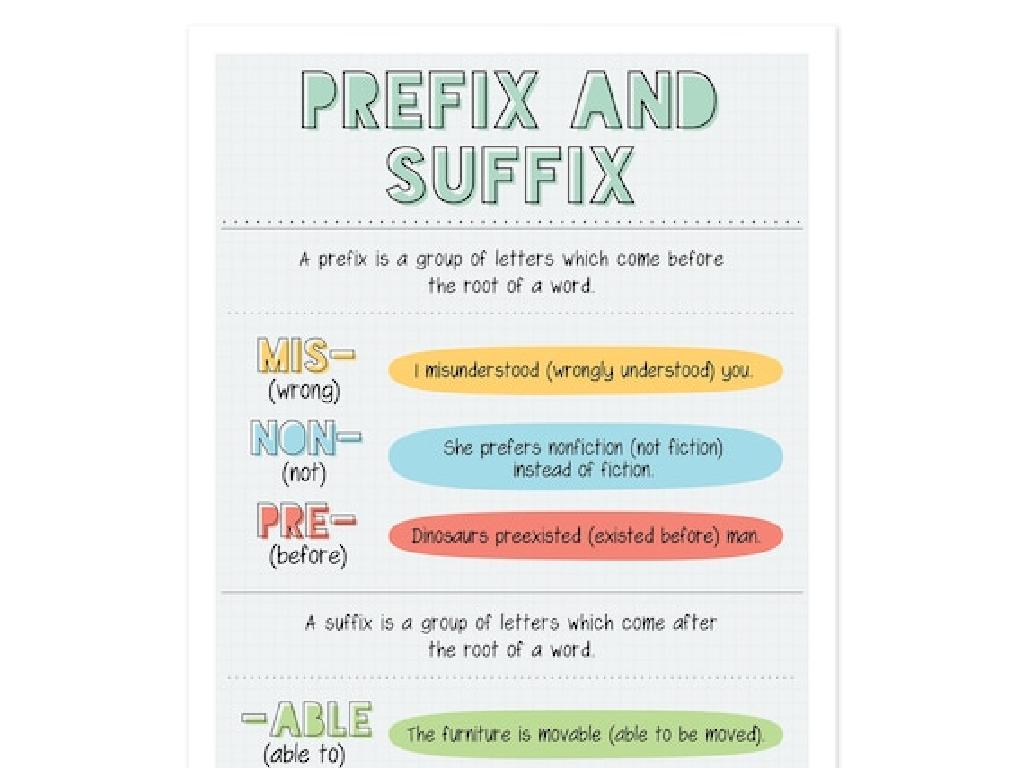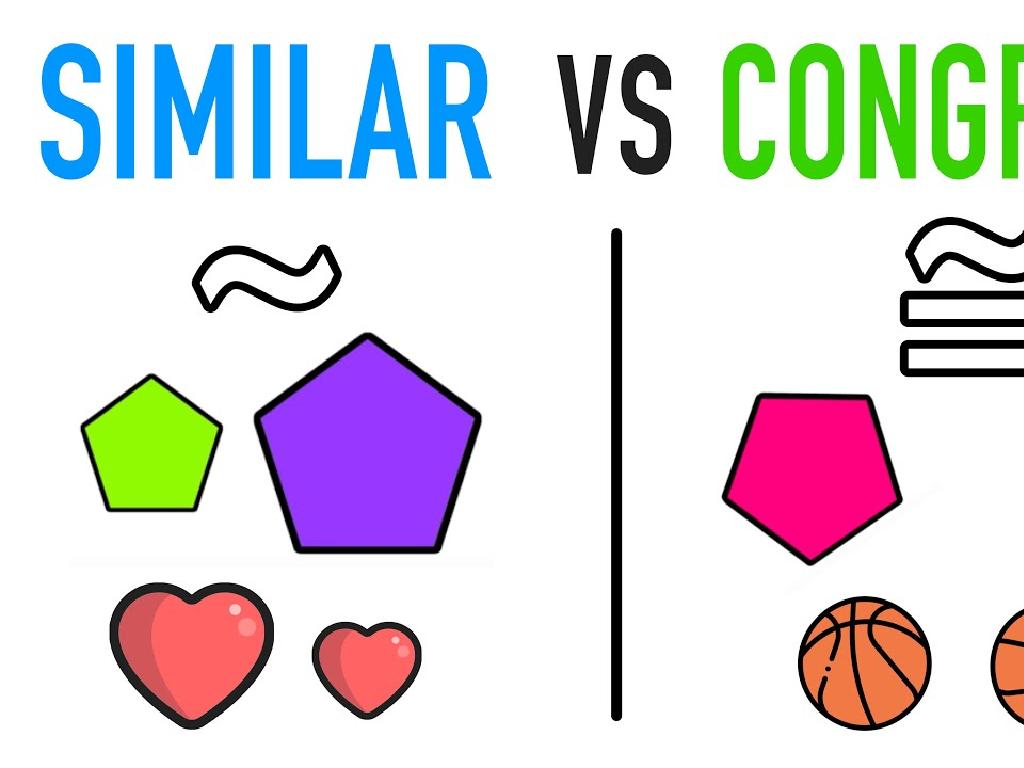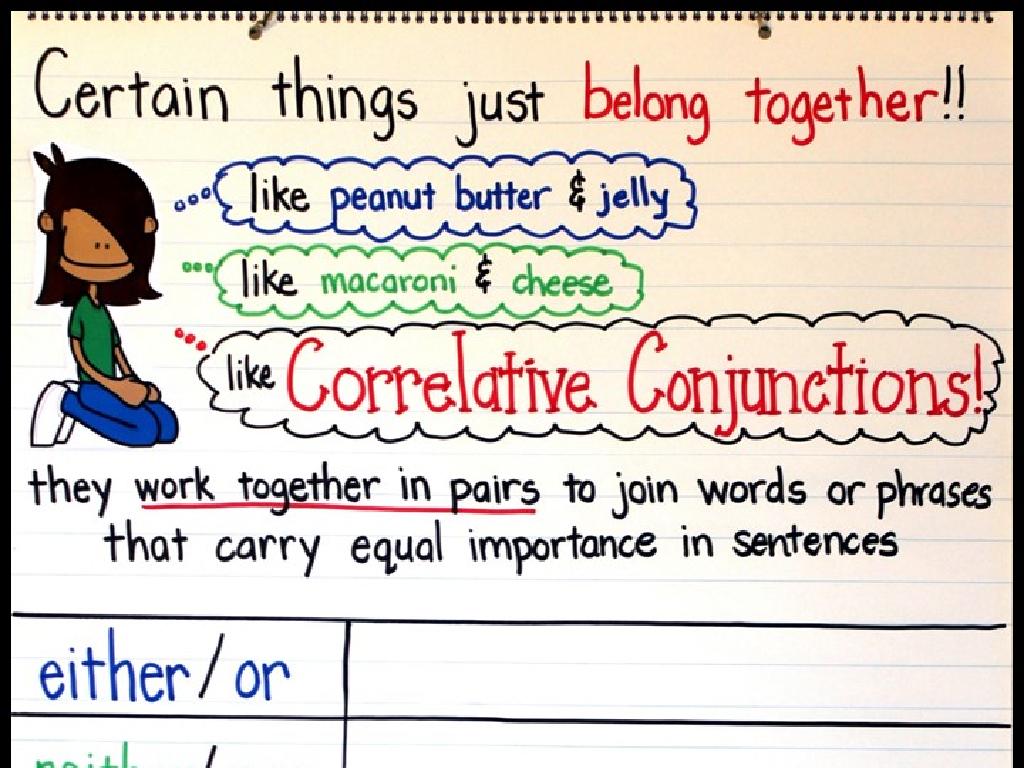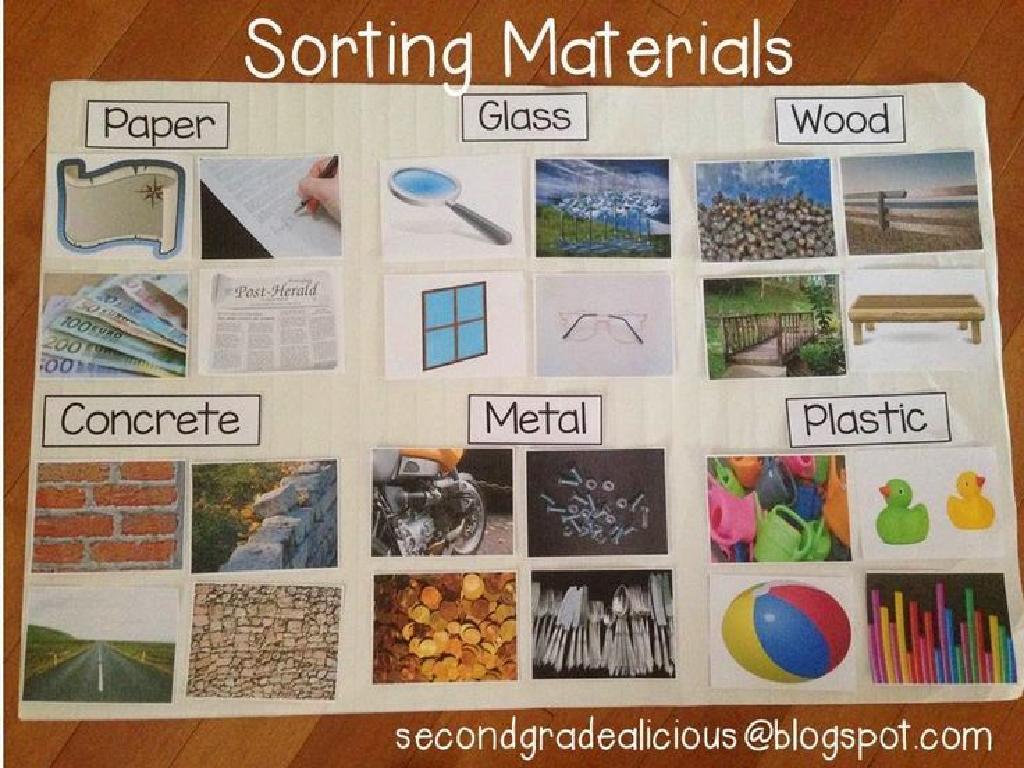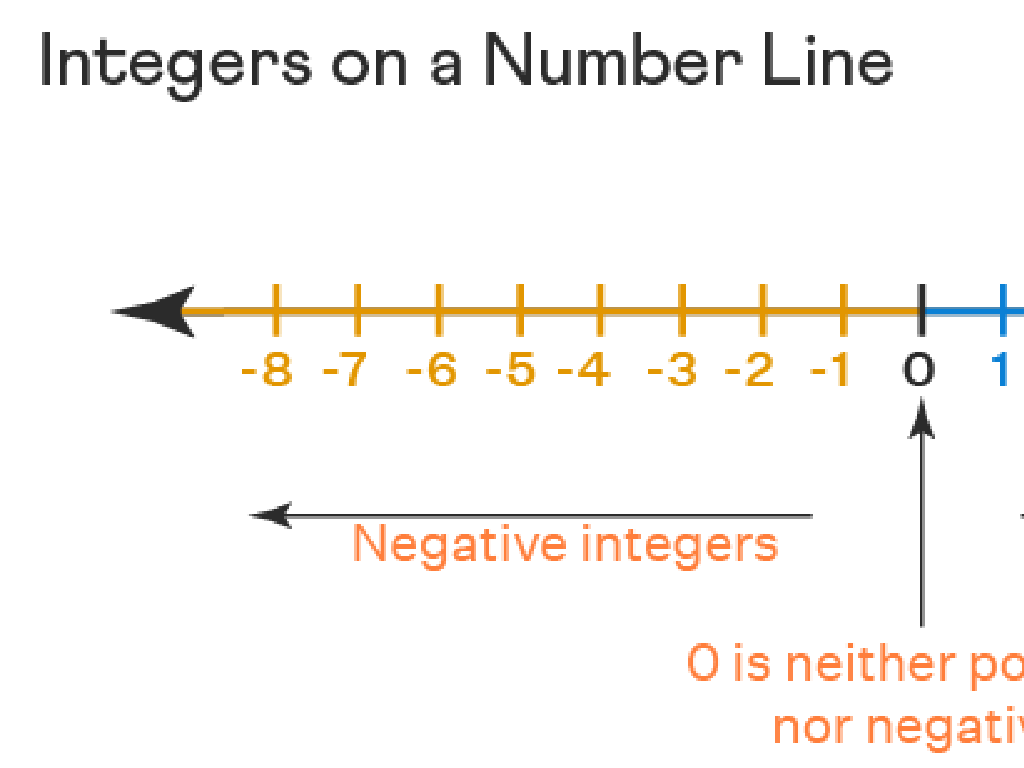Use The Perfect Verb Tenses
Subject: Language arts
Grade: Sixth grade
Topic: Verb Tense
Please LOG IN to download the presentation. Access is available to registered users only.
View More Content
Welcome to Verb Tenses!
– Understanding verb tenses
– Definition of verb tenses
– Verb tenses indicate the time of action or state of being.
– The importance of verb tenses
– They help us express time and sequence in our writing and speaking.
– Perfect tenses in English
– Perfect tenses show completed actions in relation to other events.
|
This slide introduces the concept of verb tenses to the students, emphasizing their role in indicating when an action or state of being occurs. It’s crucial to explain that verb tenses help us to communicate clearly by allowing us to express the timing of actions accurately. Understanding verb tenses is fundamental in mastering the English language, as it affects the meaning and clarity of sentences. The perfect tenses, which include past perfect, present perfect, and future perfect, are used to describe actions that are completed at the time of speaking or at a specified time and are often used in conjunction with other verb tenses. Provide examples to illustrate how the use of different tenses changes the meaning of sentences. Encourage students to think of their own examples of actions completed at different times.
Understanding Perfect Verb Tenses
– Define Perfect Verb Tense
– Expresses completed action or condition
– Explore the three types
– Past Perfect, Present Perfect, Future Perfect
– Contrast with Simple Tense
– Perfect tense shows completion, simple tense doesn’t
– Usage in sentences
– ‘I have eaten’ vs ‘I ate’, ‘She had left’ vs ‘She left’
|
The perfect verb tense is used to indicate a link between the present and the past. The main use is to show that an action was completed before another action took place. Introduce the three types of perfect tenses: past perfect for actions completed before a certain point in the past; present perfect for actions completed at an unspecified time before now; and future perfect for actions that will be completed before a specified future time. Highlight the difference between perfect and simple tenses, emphasizing that perfect tense indicates completion of an action, whereas simple tense merely indicates the action itself without a focus on its completion. Provide examples to illustrate the use of perfect tenses in sentences and encourage students to create their own examples.
Mastering Present Perfect Tense
– Forming Present Perfect Tense
– Combine ‘has/have’ with the past participle of the verb
– ‘Has’ and ‘Have’ usage
– ‘Has’ for he, she, it; ‘have’ for I, you, we, they
– Past participle in sentences
– ‘She has visited.’ ‘We have learned.’
– Practice with examples
|
The present perfect tense is formed by using ‘has’ or ‘have’ with the past participle of the main verb. This tense is used to describe actions that have happened at some time in the past and are still relevant now. For singular third-person, use ‘has,’ and for all other persons, use ‘have.’ Provide students with clear examples of sentences using the present perfect tense. Encourage them to create their own sentences using verbs they are familiar with. This will help them understand how the tense is used in various contexts. Practice is key, so consider assigning a few exercises for them to complete.
Mastering Past Perfect Tense
– Forming the Past Perfect Tense
– Combine ‘had’ with a past participle verb
– Use ‘had’ with past participles
– ‘I had walked’, ‘She had danced’
– Sentence examples
– ‘After she had finished homework, she went out’
– Understanding its usage
|
The past perfect tense is used to describe an action that was completed before another past action. To form it, use ‘had’ followed by the past participle of the verb. It’s important to ensure that students can both recognize and correctly form past perfect tense verbs. Provide examples and have students create their own sentences using this tense. Emphasize the sequence of events and how the past perfect tense sets the timeline for actions. Practice with exercises that include completing sentences and rewriting sentences in the past perfect tense.
Mastering Future Perfect Tense
– Form the Future Perfect Tense
– Combine ‘will have’ with a verb’s past participle to show an action will be completed before a specific time in the future.
– Use ‘will have’ and past participle
– ‘By next year, I will have graduated.’
– Sentence examples
– ‘She will have finished the project before the deadline.’
|
The Future Perfect Tense is used to describe an action that will be completed before a certain point in the future. To form this tense, use ‘will have’ followed by the past participle of the verb. It’s important to emphasize the time aspect as it distinguishes the Future Perfect from other tenses. Provide students with clear examples and encourage them to create their own sentences to practice. Discuss how this tense can be used to make predictions or to express the certainty of completion of an action in the future.
Perfect Tense in Action
– Identifying perfect tenses in texts
– Look for had, has, or have followed by a past participle
– Effects of perfect tenses on readers
– Perfect tenses can show completed actions or emphasize the result
– Activity: Discover perfect tenses
– Find sentences in your book that use perfect tenses
– Share examples from a favorite book
– Be ready to explain why the author used perfect tenses
|
This slide introduces the concept of perfect tenses and their impact on literature. Students will learn to identify the perfect tenses by looking for the helping verbs ‘had,’ ‘has,’ or ‘have’ followed by a past participle. Discuss how perfect tenses can affect the reader’s perception of time and completion of actions. The activity encourages students to apply this knowledge by finding examples in books they enjoy. This will help them understand the practical use of perfect tenses and their effect on storytelling. In the next class, students will share their findings, explaining the author’s choice of tense and how it influences the narrative.
Practice Makes Perfect: Mastering Perfect Tenses
– Fill in blanks with perfect tenses
– Use past, present, or future perfect tense verbs to complete sentences.
– Correct sentences with tense errors
– Find and fix the incorrect verb tenses in given sentences.
– Write sentences using perfect tenses
– Create your own examples of sentences for all three perfect tenses.
– Understand usage of each perfect tense
|
This slide is an interactive activity to reinforce the students’ understanding of perfect verb tenses. Start by providing sentences with missing verbs and ask students to fill in the blanks using the correct perfect tense. Then, present sentences with incorrect verb tenses and have the students correct them. Encourage students to write their own sentences using past, present, and future perfect tenses to demonstrate their grasp of the concept. This exercise will help students recognize and use perfect tenses correctly in various contexts. Provide guidance on how each tense is formed and used, and offer examples for each. The goal is for students to become comfortable with identifying and using all three perfect tenses in their writing.
Class Activity: Perfect Tense Time Capsule
– Write a time capsule story
– Use past, present, and future perfect tenses
– Include ‘has/have + past participle’ for present perfect
– Share with a classmate
– Discuss the role of perfect tenses
– How do perfect tenses clarify the time of actions?
|
In this activity, students will create a story that incorporates past, present, and future perfect tenses to understand how these tenses function in describing the sequence of events. The past perfect tense (‘had + past participle’) shows actions that were completed before another action. The present perfect tense (‘has/have + past participle’) describes actions that happened at an unspecified time or that started in the past and continue in the present. The future perfect tense (‘will have + past participle’) indicates actions that will be completed before some point in the future. After writing, students will pair up to share their stories and discuss how the use of perfect tenses helps to understand the timeline of events. This will help them grasp the concept of time in narrative form. Possible activities include writing about a character’s life achievements, a series of events leading up to a future goal, or historical events leading up to a present situation.
Perfect Verb Tenses: Conclusion & Recap
– Review of perfect verb tenses
– Importance of correct tense usage
– Using the right tense helps convey the correct time frame of actions
– Homework: Craft a short story
– Use past, present, and future perfect tenses in your story
– Incorporate all three perfect tenses
– Show how actions were completed at different times
|
As we wrap up our lesson on perfect verb tenses, it’s crucial to revisit the concepts to ensure understanding. Emphasize the importance of using the correct tense to accurately describe when actions have been completed. For homework, students will write a short story that includes past perfect (actions completed before something else), present perfect (actions completed at an unspecified time before now), and future perfect (actions that will be completed before a specific time in the future) tenses. This exercise will help students apply what they’ve learned in a creative context and demonstrate their grasp of the material. Encourage them to think about the sequence of events in their story to effectively use each tense.

